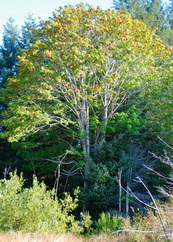 The thing about maple bark skirts is that they are pretty much made of just the inner bark of maple. This focuses attention on the resource itself and on our relationship with the resource. Maple is fire adapted, a prolific sprouter, and self-pruning (branches not carrying their photosynthetic weight will be discarded by the tree itself). There is great variation among trees. Trees may be multi-trunked, or have a single thick trunk with a deeply furrowed bark. Some are better for stripping than others. I spoke with as many practitioners as I could and tested all the various “rules” for harvesting Maple and found, almost without exception, they didn’t always work. Many factors affect whether bark will peel. The window may be short in hot, drier locations but might extend into late fall in higher, cooler locations. But then, the place that peeled so well last July, just doesn’t the next July. I located only one Karuk story instructing use of maple. But many stories talked about gathering fire wood and about burning logs. Hum, how’d they cut down those trees back in the day? I also know our traditions assigned gathering “rights” to areas, and that maple is very common throughout our traditional territory, including village areas. The more I learned about maple, the clearer it became to me that our system of rights brings with it responsibilities. For example, we use to burn as a means to control insect pests, clear slash, and enhance plant growth in ways that support the health of the plant and the needs of the people. Managing a particular area one would be in relationship with the land and all that lives on it. One would know the plants and animals, weather patterns, and other factors that might impact use of resources. Now days, because many people access the forest, generally only narrow strips of Maple are taken from any one trunk to minimize “damage” to a tree. But what’s better, damaging each truck of a multi-trunked tree, or entirely stripping one of the trunks so the tree will discard it (self-prune), thus delivering firewood? Back in the day, I think I would have let the tree work with me. Mary J. Risling is the founder and Executive Director for the Me'Dil (Maintaining, Enhancing and Defending Indigenous Living) Institute, a nonprofit organization. She is an accomplished regalia maker and owner.
1 Comment
Shannon Boone
8/29/2014 04:07:22 am
Wonderful story with pictures. Beautiful work!
Reply
Your comment will be posted after it is approved.
Leave a Reply. |
About:The Northwest Coast Regalia Stories Project explores the life stories of cultural regalia pieces for Northwest California Native peoples. Read More... Start
About the Dresses California History Native American Women & Regalia Regalia Stories Links & Sources Feedback/ Evaluation Form Archives
August 2016
Categories |



 RSS Feed
RSS Feed
